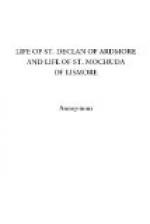“St. Declan’s Well,” beside some remains of a rather large and apparently twelfth century church on the cliff, in the townland of Dysert is diverted into a shallow basin in which pilgrims bathe feet and hands. Set in some comparatively modern masonry over the well are a carved crucifixion and other figures of apparently late mediaeval character. Some malicious interference with this well led, nearly a hundred years since, to much popular indignation and excitement.
The second “St. Declan’s Stone” was a small, cross-inscribed jet-black piece of slate or marble, approximately—2” or 3” x 1 1/2”. Formerly it seems to have had a small silver cross inset and was in great demand locally as an amulet for cattle curing. It disappeared however, some fifty years or so since, but very probably it could still be recovered in Dungarvan.
Far the most striking of all the monuments at Ardmore is, of course, the Round Tower which, in an excellent state of preservation, stands with its conical cap of stone nearly a hundred feet high. Two remarkable, if not unique, features of the tower are the series of sculptured corbels which project between the floors on the inside, and the four projecting belts or zones of masonry which divide the tower into storeys externally. The tower’s architectural anomalies are paralleled by its history which is correspondingly unique: it stood a regular siege in 1642, when ordnance was brought to bear on it and it was defended by forty confederates against the English under Lords Dungarvan and Broghil.
A few yards to north of the Round Tower stands “The Cathedral” illustrating almost every phase of ecclesiastical architecture which flourished in Ireland from St. Patrick to the Reformation—Cyclopean, Celtic-Romanesque, Transitional and Pointed. The chancel arch is possibly the most remarkable and beautiful illustration of the Transitional that we have. An extraordinary feature of the church is the wonderful series of Celtic arcades and panels filled with archaic sculptures in relief which occupy the whole external face of the west gable.
St. Declan’s foundation at Ardmore seems (teste Moran’s Archdall) to have been one of the Irish religious houses which accepted the reform of Pope Innocent at the Lateran Council and to have transformed itself into a Regular Canonry. It would however be possible to hold, on the evidence, that it degenerated into a mere parochial church. We hear indeed of two or three episcopal successors of the saint,




